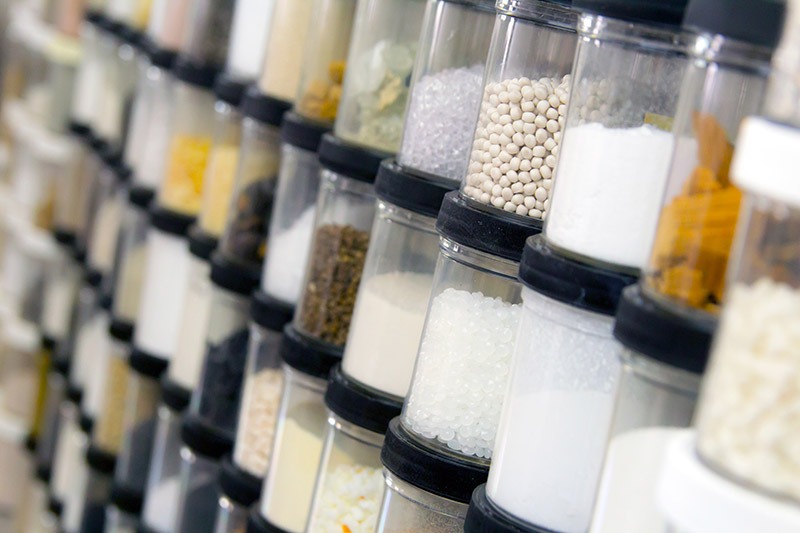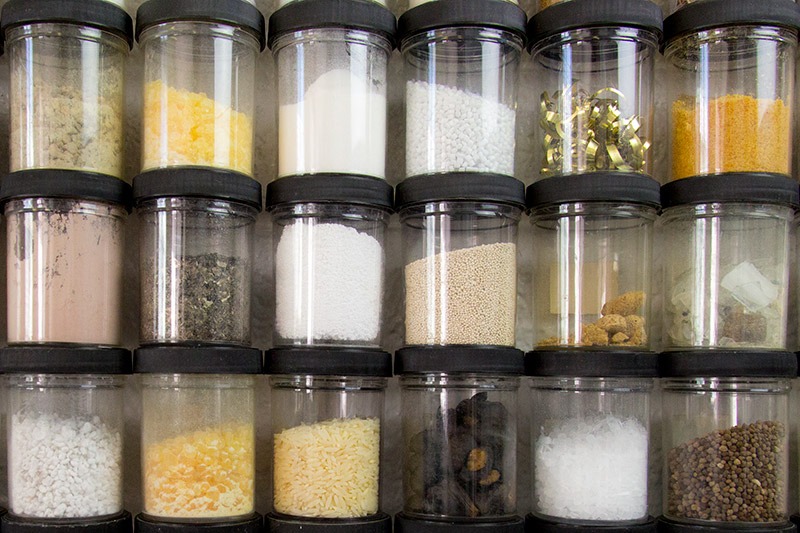Materials
United States Systems, Inc. has conveyed thousands of materials since its founding in 1969. Form follows function in our design process and it all flows from the specific properties of the materials we’re handling. You can trust in our vast experience to build you ‘Uncommonly Good’ industrial equipment to handle your material.
Whether you need to bag it, sift it, filter it, fill it, pack it, weigh it, roll it, convey it, vacuum it, or blow it, we’ve got it covered.

Material Characteristics
Pneumatic Conveying system design is highly dependent on the type of material conveyed because every material has different properties that interact with the components of the system and the conveying air in a myriad of different ways.
Bulk Materials are classified according to particle size, flow characteristics, hardness, and more. Here is a description of the characteristics US Systems uses to analyze material when designing pneumatic conveying systems.
| CHARACTERISTIC | DESCRIPTION |
| Particle Shape | The geometric form of the particles |
| Particle Size | The dimensions of individual particles |
| Bulk Density | Mass per unit volume of bulk sodium bicarbonate |
| Abrasiveness | Ability to cause wear on equipment |
| Corrosiveness | Tendency to corrode materials it contacts |
| Flowability | Ease with which the material flows |
| Moisture Content | Amount of water present in the material |
| Temperature | The operating temperature of the material |
| Chemical Composition | The elements and compounds present in the material |
| Cohesion/Adhesion | Tendency to stick to itself or other surfaces |
| Compressibility | Ability to decrease in volume under pressure |
| Wall Friction | Resistance to flow when in contact with container walls |
| Cohesiveness | The degree to which particles stick together |
| Hygroscopicity | Ability to absorb moisture from the air |
| Static Charge | Tendency to accumulate electrical charge |
| Explosivity | Potential to cause explosions |
| Melt Point | Temperature at which the material melts |
| Crystal Structure | The arrangement of atoms in the material |
| Form of Particles | The physical state of individual particles |
| Absorption of Odors | Ability to absorb smells |
FACTORS IMPACTING FLOWABILITY OF BULK MATERIALS
The flow of bulk materials is a complex and multifaceted phenomenon influenced by various physical properties and environmental conditions. One of the primary factors is bulk density, which refers to the mass per unit volume of a material, including the void spaces between particles. This property significantly impacts the design and capacity of storage vessels, feeders, and conveyors. Particle size and distribution also play a crucial role in determining flow behavior. Materials with a wide range of particle sizes may exhibit different flow characteristics compared to those with uniform particle sizes. For instance, fine particles tend to flow more cohesively, while larger particles are more prone to segregation and bridging. Additionally, particle shape affects how easily materials can flow; spherical particles typically flow more easily than irregularly shaped ones due to lower interparticle friction.
Moisture content is another vital factor, as it can alter the flow properties of bulk materials. High moisture levels can cause materials to become cohesive and sticky, leading to clumping and potential blockages. Conversely, very dry materials may generate dust, posing handling and environmental challenges. Cohesion and adhesion further influence flow behavior; cohesion is the internal force that holds particles together, while adhesion is the attraction between particles and container surfaces. High cohesion can lead to arching and rat-holing in hoppers and silos, whereas high adhesion increases wall friction, hindering smooth flow.
The angle of repose, which is the steepest angle at which a pile of bulk material remains stable, provides a measure of flowability. Materials with a low angle of repose flow more easily, while those with a high angle are prone to forming stable heaps. Flow function is a measure of a material’s flowability under different consolidation stresses, helping predict behavior in storage and handling equipment. Compressibility, the ability of a material to decrease in volume under pressure, affects storage and handling, with highly compressible materials requiring agitation to maintain flow.
Permeability, or the ability of a material to allow air or gas to pass through, impacts aeration and flow. High permeability materials are easier to aerate, facilitating smoother flow. Segregation, the separation of particles based on size, density, or other properties, can lead to non-uniform mixtures and affect product quality. Wall friction, the resistance encountered by material flowing against container walls, influences the design of storage vessels. Low wall friction materials flow more easily and are less likely to form stable arches or ratholes.
Flow patterns, such as mass flow (where all material moves together) and funnel flow (where only the central core moves), affect discharge consistency and storage efficiency. Finally, environmental factors like temperature and humidity can influence flow properties, with high humidity increasing moisture content and affecting flow behavior. Understanding these intricate properties and designing systems to manage them ensures efficient, reliable, and safe handling of bulk materials in various industrial applications.
PNEUMATIC CONVEYING BULK MATERIALS
D
M
N
P





